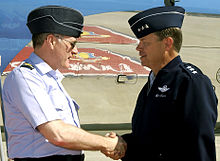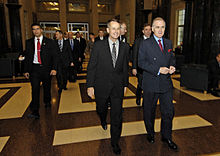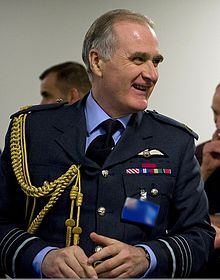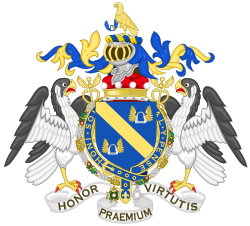Jock Stirrup
The Lord Stirrup | |
|---|---|
 Official portrait, 2020 | |
| Nickname(s) | Jock |
| Born | 4 December 1949 Paddington,London |
| Allegiance | United Kingdom |
| Service/ | Royal Air Force |
| Years of service | 1968–2011 |
| Rank | Marshal of the Royal Air Force |
| Service number | 8020760D |
| Commands held | Chief of the Defence Staff(2006–10) Chief of the Air Staff(2003–06) No. 1 Group(1997–98) RAF Marham(1990–92) No. 2 Squadron(1985–87) |
| Battles/wars | Dhofar War Cold War Operation Telic War in Afghanistan |
| Awards | Knight Companion of the Order of the Garter Knight Grand Cross of the Order of the Bath Air Force Cross |
Marshal of the Royal Air ForceGraham Eric Stirrup, Baron Stirrup,KG,GCB,AFC,FRAeS,FCMI(born 4 December 1949), informally known asJock Stirrup,is a former seniorRoyal Air Forcecommander who was theChief of the Defence Stafffrom 2006 until his retirement in late 2010. He is now aCrossbenchmember of theHouse of Lords.In April 2013, he was appointed aKnight Companion of the Order of the GarterbyQueen Elizabeth II.
As a junior RAF officer, Stirrup was a jet pilot, and saw action in theDhofar War.Later in his career, he commandedNo. 2 SquadronandRAF Marham.After several senior air force appointments, Stirrup was made the Deputy Commander-in-Chief ofStrike Commandand during this time he served as the first commander ofBritish forces engaged in fighting the Taliban.In 2002, Stirrup was appointed the Deputy Chief of the Defence Staff responsible for equipment and capability and was heavily involved in procuring equipment for theinvasion of Iraq.Spending a little over a year in that role, he was then appointed theChief of the Air Staff,in which capacity he served from 2003 to 2006. He became Chief of the Defence Staff in 2006: during his time in office the British Armed Forces faced significant commitments both to Iraq (Operation Telic) and Afghanistan (Operation Herrick). Stirrup retired as Chief of the Defence Staff on 29 October 2010, taking a seat in the House of Lords in 2011.
Early and personal life[edit]
Graham Eric Stirrup was born on 4 December 1949, the son of William Hamilton Stirrup and his wife, Jacqueline Brenda Stirrup (néeCoulson).[1]He was educated atMerchant Taylors' SchoolinNorthwood,Hertfordshire.[1]
Stirrup married Mary Alexandra Elliott in 1976 and they have one son.[2]Stirrup includes golf, music, theatre and history among his interests.[1]He is a fellow of theRoyal Aeronautical Society,[1]a fellow of theChartered Management Institute[1]and a member of theSociety of Knights of the Round Table.[3]
RAF career[edit]
Stirrup started his military career at theRAF College CranwellinLincolnshireon 1 April 1968[4]and it was from Cranwell that he received hiscommissionon 31 July 1970.[5]He was promoted toflying officeron 31 July 1971 with seniority backdated to 31 January,[6]and toflight lieutenantfrom 31 July 1973.[7]From 1973 to 1975, Stirrup was on loan service with theSultan of Oman's Air Force.[2]
In Oman, Stirrup flewBAC Strikemastersduring theDhofar Warin theclose air supportandinterdictionroles, giving him valuable battle experience of the use ofair powerincounter-insurgencyoperations.[8]After he returned to the United Kingdom in 1975, Stirrup was posted toNo. 41 Squadronwhere he flew theSEPECAT Jaguarin the fighter reconnaissance role.[2]Stirrup went on to serve in an exchange tour in theUnited Stateswhere he flew the all-weather tactical reconnaissanceRF-4C Phantom.[9]

Promoted tosquadron leaderon 1 January 1980,[10]Stirrup was serving as a flight commander onNo. 226 Operational Conversion Unitwhich was based atRAF Lossiemouthin March 1983: his duties centred around the instruction of trainee pilots on theSEPECAT Jaguarand, on 7 March 1983, Stirrup was carrying out a student progress check from the rear seat of his aircraft when they suffered a seriousbird strike.[11]Stirrup was unable to ascertain whether his student was conscious and forward vision through the canopy was obscured: one of his engines caught fire, and although ejecting from the aircraft would have been justified, not knowing whether the student was conscious or not, Stirrup managed to land atRAF Leuchars.[11]Stirrup was later awarded theAir Force Crossin recognition of his handling of the incident.[11]
Stirrup was promoted towing commanderon 1 July 1984.[12]In 1985 Stirrup received a command appointment, as the Officer CommandingNo. 2 Squadronwhich at that time was operating the Jaguar fromRAF LaarbruchinWest Germany:along with otherNATOair units, his squadron's role was low-level tactical reconnaissance in the face of theSovietCold Warthreat.[9]Stirrup gained first hand experience of the higher-level workings of the RAF when, in 1987, he was appointed Personal Staff Officer to theChief of the Air Staff.[9]
Having been promoted togroup captainon 1 January 1990,[13]from 1990 to 1992, Stirrup served as Station Commander ofRAF Marham[14]and during his time in command, RAF Marham's strike aircraft were dispatched to the Middle East, seeing action in theGulf War air campaign.[9]In 1993 Stirrup attended theRoyal College of Defence Studies(RCDS).[9]Stirrup was promoted toair commodoreon 1 January 1994,[15]and appointed Director of Air Force Plans and Programmes that year.[9]Promoted toair vice-marshalon 1 July 1997,[16]he becameAir Officer CommandingNo. 1 Groupin April 1997,Assistant Chief of the Air Staffin August 1998 and, having been promoted toair marshalon 6 November 2000,[17]he was made DeputyCommander-in-ChiefRAF Strike Commandthat year.[9]His appointment at Strike Command also entailed taking on the additional roles of being the Commander of NATO'sCombined Air Operations Centre 9(based at High Wycombe) and serving as the Director of theEuropean Air Group.[9]
From September 2001 to January 2002, Stirrup was UK National Contingent Commander forOperation Veritas(British operations against theTaliban) inAfghanistan,his first direct experience of front-line operations overseas since 1987.[9]In this role Stirrup directed the British contribution to the US-ledOperation Enduring Freedomand he was the Senior British Military Advisor to GeneralTommy Franks,the Commander-in-Chief ofUnited States Central Command.[18]AtMacDill Air Force Base,Stirrup headed the 60 strong British team who were contributing to the US-led operational planning.[19]Stirrup was replaced by Lieutenant GeneralCedric Delves.[18]

In April 2002 Stirrup was appointedDeputy Chief of the Defence Staff (Equipment Capability),a post he held until May 2003.[2]His main task was production of equipment plans for the Army, Air Force and Navy while ensuring that the plans could be afforded over the coming years. The planning for theinvasion of Iraqrequired new equipment and Stirrup became increasingly involved in planning for urgent operational requirements. A particular difficulty faced by Stirrup was the need to place equipment orders with industry before the Government was prepared to publicly commit to the action. Stirrup briefed ministers on this point but was prevented from placing the orders according to his desired timescale. In the end some critical items such asbody armour,boots and desert clothing were not available to all the personnel who needed them when they deployed.[20][21]
Stirrup was promoted toair chief marshal[22]and appointedChief of the Air Staffon 1 August 2003.[9]In July 2004 Stirrup set out his strategic direction for the RAF which was based upon working to achieve an increasingly modern and multi-role aircraft fleet, reducing the number ofRAF stationsby creating fewer but larger and better-equipped bases and reducing the number of personnel while maintaining or improving their training.[23]
Chief of the Defence Staff[edit]
Stirrup was appointedChief of the Defence Staff– just when the British Armed Forces were facing significant commitments both to Iraq (Operation Telic) and Afghanistan (Operation Herrick) – on 28 April 2006.[9]
Operations in Iraq[edit]

In May 2006, shortly after becoming CDS, Stirrup visited Iraq to assess the situation first hand. The British responsibility was in the south of Iraq and on his return Stirrup reported to theDefence SecretarythatBasrawas the key to success in southern Iraq. Stirrup identified two obstacles to success, the first being the militias and the second being the need for an acceptable level of Iraqi governance. In addition, he took the view thatIranianinterference was a significant exacerbating factor. Noting that neither of two obstacles could be fully dealt with by the British Armed Forces, Stirrup viewed the solution as being essentially political.[20]
In order to take action against the militias, the local British commander in South East Iraq developed a plan to conduct aggressive operations against them. At the same time Stirrup became increasingly concerned that strong political leadership from the Iraqis was lacking and that without this any gains made by the military actions against the militias would be to no avail. In July 2006, Stirrup overturned the previous military advice to the Defence Secretary by stating that force levels inSouth East Iraqwould need to be maintained. Previously it had been thought that they could be reduced from over 7,000 to between 3,000 and 4,000. In September 2006, the Iraqi Prime Minister,Nouri al-Maliki,blocked the British plan to act against the militias which Stirrup believed was because of Maliki's dependence onSadristsupport at that stage.[20]
The original British plan was replaced byOperation Sinbadwhich was acceptable to the Iraqis and was executed from September 2006 to February 2007. Along with other Coalition commanders, Stirrup viewed Sinbad as insufficient because it did not involve directly attacking the militias. Believing that it would not deliver the level of improvements in security that the British wanted, Stirrup began looking at the high risk strategy of withdrawing British troops from inside Basra which would have left the Iraqis in the position of either having to deal with the security problems themselves or losing control of Iraq's second city.[20]
Following the end of Operation Sinbad, the military situation for the British in Basra worsened and the British base atBasra Palace was repeatedly attacked.However, by summer 2007, Maliki's political position no longer depended on Sadrist support andMuqtada al-Sadrhad publicly criticized Maliki. In July 2007 Maliki replaced his Basra security co-ordinator and during one of his visits to Iraq, Stirrup met the new Basra security coordinator,General Mohan.Mohan wanted the British forces to withdraw from Basra and Stirrup stressed that once British forces had departed, Mohan's Iraqi forces would have to deal with security. Both Mohan and Stirrup were clear that retaining British forces outside Basra would be an insurance policy against a deteriorating situation within Basra as well as give Mohan something additional with which he could threaten the militias. Stirrup was concerned that a redeployment would look as though the British had been "bombed out of Basra" but judged that this was preferable to the significant damage to British military reputation were security in Basra to completely break down.[20]Much of the British redeployment took place in August and despite Stirrup making public statements to the effect that the withdrawal was part of the overall plan, some commentators judged that the British had been defeated in southern Iraq.[24]By early September all British troops had been withdrawn from Basra city tothe airportto perform what was dubbed an "overwatch" role.[25]
After British troops had been withdrawn from Basra city, violence continued and General Mohan took some time to produce a plan for improving security. Notwithstanding the difficulties, theBasra Governoratewas handed over toProvincial Iraqi Controlin December 2007.[26]By early March 2008, General Mohan had produced a security plan with British support which was presented toGeneral Petraeusand Prime Minister Maliki inBaghdad.The plan called for a six-week period of disarmament, demobilisation and reintegration starting in June 2008 before forcibly disarming theMahdi Armyand other non-Government/Coalition forces afterwards. Later in March Stirrup was in Baghdad and he met with General Petraeus andGeneral Austin,the commander of theMulti-National Corps – Iraq.Stirrup strongly backed Mohan's plan but noted that Mohan would need to be pressed hard to deliver and also supported with Corps forces. Austin was reluctant to provide support, wishing to focus onMosul,but Petraeus agreed with Stirrup. However, this plan was overtaken by Maliki's decision to launchOperation Charge of the Knights.Both Stirrup and the American commanders were taken by surprise and were concerned about the lack of planning but Maliki was determined to launch his operation in late March.[20]

Operation Charge of the Knights led to the Battle of Basra which lasted from 25 to 31 March. Although the lack of planning resulted in some confusion, the Coalition did support the Iraqi action with land and air assets. By the end of March the Iraqi Government forces had negotiated a ceasefire with Muqtada al-Sadr. With the militias melting away, Iraqi Government forces were able to claim control of Basra. While recognizing that Operation Charge of the Knights had been far from perfect, Stirrup judged it to be a success as the Iraqis were taking responsibility for their own security.[27]
After the conclusion of Operation Charge of the Knights the British were involved in helping to rebuild those Iraq Army units which had suffered from poor cohesion, or even dissolved. In hindsight, Stirrup took the view that the British forces would have been usefully employed in mentoring the Iraq Army to greater extent earlier in the campaign.[20]In late April 2009, most British military operations in Iraq came to an end; and by 28 July 2009 all British forces had left Iraq and were all redeployed to Kuwait.[28]
Operations in Afghanistan[edit]

After his appointment as CDS, Stirrup travelled toHelmand Provincein May 2006. At that stage, the British effort consisted of a small tented base atCamp Bastion,an operating base atLashkar Gahand several isolated platoon houses in the north of Helmand. Much of the rest of the Province was not under British or otherISAFcontrol. At that time the insurgency was starting to gain strength and although by 2009 the British Armed Forces and theUnited States Marine Corpshad greatly expanded their role and were providing security for over 50% of Helmand, speaking in 2009 Stirrup conceded that in some areas security had worsened. While, highlighting the inadequate force levels provided by NATO and the competing demands on Coalition political and military resources that Iraq had posed until 2008, Stirrup believed that by 2009 NATO forces were successfully taking the fight to the insurgents, driving them out of towns and villages and thereby allowing governance to improve which would lead to the defeat of the insurgency.[29]
Speaking generally on operations in Afghanistan, Stirrup has noted that whilst "the military is a key, an essential element in dealing with those problems, but by and large these problems can only be resolved politically" and that he favoured a pragmatic approach to dealing with former members of theTaliban.[30]By December 2009, Stirrup was expressing his concern about falling levels of public support for the war in Afghanistan which he believed risked undermining the British effort. In particular Stirrup called for a spirit of resolution and stated that the mission was achievable, noting that the British Armed Forces had finally now got a properly resourced plan to achieve the strategic aim.[31]
Extended term of office and retirement[edit]
On 14 July 2010, the Defence Secretary Liam Fox announced that GeneralSir David Richards,the thenChief of the General Staff,would succeed Stirrup as Chief of the Defence Staff in October 2010.[32]Richards took over on 29 October 2010 and Stirrup was created alife peerasBaron Stirrup,ofMarylebonein theCity of Westminster.[33]He wasintroducedinto theHouse of Lordson 1 February 2011, where he sits as acrossbencher.[34]Stirrup officially retired from the RAF on 4 April 2011.[35]The following month Stirrup gave detailed evidence to the CommonsDefence Select Committeeon the UK's recentStrategic Defence and Security Review.[36]
In April 2013, Stirrup was appointedKnight Companion of the Order of the Garterby theQueen Elizabeth II.[37][38]He was appointed as an honoraryMarshal of the Royal Air Forcein the Queen's2014 Birthday Honours.[39][40]
Activities as a peer[edit]


In 2013 Stirrup, along with Field MarshalLord Guthrieand Admiral of the FleetLord Boyce,called upon the British Government to derogate from theEuropean Convention on Human Rightsfor the duration of deployed operations. They were concerned that the increased risk of prosecution faced by commanders would lead to a generation of risk-averse military leaders.[41]In August 2014, Stirrup was one of 200 public figures who were signatories to a letter toThe GuardianopposingScottish independencein the run-up to September'sreferendum on that issue.[42]In June 2015 Stirrup joined the House of Lords' EU External Affairs Sub-Committee.[43]From October 2015 Stirrup has been the president of thePilgrims Society.[44]
OnRemembrance Sunday2014, it was announced that Stirrup would lead the efforts to raise one million pounds to enable a national memorial to the British service personnel who fought in Iraq and Afghanistan to be erected in central London.[45]By March 2015 Stirrup was confident that the full amount needed could be raised[46]and by July 2016 work had begun on the memorial in theVictoria Embankment Gardens.TheIraq and Afghanistan Memorialwas unveiled in March 2017.[47]
In July 2016, Stirrup gave an interview toSky Newsin which he accused Russia of running a "gangster regime" and a "gangster foreign policy" in regard to theirongoing Ukrainian intervention.Noting that the Kremlin viewed NATO as weak, Stirrup called for the West to develop a long-term strategy to counter Russia's actions. In particular Stirrup urged that NATO countries spend more on defence.[48]
Stirrup carried theSword of Statein the procession for the 2019 State opening of Parliament.[49]
Honours[edit]
Stirrup has received the following honours:
- Honorary Colonel 73 Engineer Regiment (Volunteers) (1 April 2002 – 1 June 2008)[50][51]
- Doctor of SciencefromCranfield University[1]
- Air Aide-de-Campto Her Majesty The Queen[22]
| Knight Companion of the Order of the Garter(KG) | 2013[52] | |
| Knight Grand Cross of the Order of the Bath(GCB) | 2005[53] | |
| Knight Commanderof the Order of the Bath (KCB) | 2002[54] | |
| Companion of the Order of the Bath (CB) | 2000[55] | |
| Air Force Cross(AFC) | 1983[56] |
Arms[edit]

|
|
References[edit]
- ^abcdefWho's Who2010,A & C Black,2010,ISBN978-1-4081-1414-8
- ^abcdPearson, Jonathan, ed. (2009).Dod's Civil Service Companion 2009–2010.London: Dods. p. 159.ISBN978-0-905702-85-8.Retrieved20 May2012.
- ^"Membership".Society of Knights of the Round Table. Archived fromthe originalon 8 February 2012.Retrieved20 May2012.
- ^Stirrup, Graham Eric (27 January 2014).Statement by ACM Lord Graham Eric "Jock" Stirrup.Museum of Tel Aviv: Tel Aviv University. Event occurs at 4:33.Archivedfrom the original on 21 December 2021.Retrieved11 May2015.
- ^"No. 45186".The London Gazette(Supplement). 4 September 1970. p. 9882.
- ^"No. 45438".The London Gazette(Supplement). 2 August 1971. p. 8340.
- ^"No. 46046".The London Gazette(Supplement). 7 August 1973. p. 9402.
- ^"Security & Stabilisation: the military contribution"(PDF).Ministry of Defence. Archived fromthe original(PDF)on 18 October 2011.Retrieved20 May2012.
- ^abcdefghijk"Sir Jock Stirrup".NATO. Archived fromthe originalon 11 October 2012.Retrieved20 May2012.
- ^"No. 48100".The London Gazette(Supplement). 18 February 1980. p. 2642.
- ^abc"No. 49413".The London Gazette(Supplement). 11 July 1983. p. 9151.
- ^"No. 49800".The London Gazette(Supplement). 9 July 1984. p. 9435.
- ^"No. 52005".The London Gazette.2 January 1990. p. 73.
- ^"RAF Station Commanders – East Anglia".Air of Authority – A History of RAF Organisation.Retrieved20 May2012.
- ^"No. 53537".The London Gazette(Supplement). 31 December 1993. p. 20689.
- ^"No. 54820".The London Gazette(Supplement). 30 June 1997. p. 7559.
- ^"No. 56020".The London Gazette(Supplement). 7 November 2000. p. 12489.
- ^ab"SAS chief takes top Afghan war job".BBC. 4 January 2002.Retrieved20 May2012.
- ^Schmitt, Eric (30 November 2001)."Many Eager to Help, but Few Are Chosen".The New York Times.Retrieved25 May2016.
- ^abcdefg"Evidence by Sir Jock Stirrup to the Iraq Inquiry"(PDF).Iraq Inquiry. 1 February 2010.Retrieved20 May2012.
- ^Jones, Sam (1 February 2010)."Troops sent to Iraq without sufficient body armour, Chilcot inquiry told".The Guardian.London.Retrieved20 May2012.
- ^ab"No. 57018".The London Gazette(Supplement). 5 August 2003. p. 9733.
- ^"Delivering Security in a Changing World".21 July 2004. Archived fromthe originalon 5 November 2012.Retrieved20 May2012.
- ^"Instructions to troops in Basra: keep fingers crossed".Time. 28 August 2007.Retrieved20 May2012.
- ^"The 'proxy war': UK troops are sent to Iranian border".The Independent.12 September 2007. Archived fromthe originalon 8 July 2012.
- ^"Iraq to be given control of Basra".BBC. 9 December 2007.Retrieved20 May2012.
- ^"Air Chief Marshal Sir Jock Stirrup's Speech 2009".RUSI. 1 December 2008.Retrieved20 May2012.
- ^"UK troops in Iraq moved to Kuwait".BBC. 28 July 2009.Retrieved20 May2012.
- ^"Annual Chief of the Defence Staff Lecture".RUSI. 3 December 2009.Retrieved20 May2012.
- ^Holt, Richard (25 October 2007)."Stirrup: 'No military solution in Afghanistan'".The Telegraph.London.Retrieved20 May2012.
- ^"Loss of Support 'More Damaging Than Taliban'".Sky News. 3 December 2009.Retrieved20 May2012.
- ^"General Sir David Richards to be Chief of Defence Staff".The Telegraph.London. 14 July 2010. Archived fromthe originalon 18 July 2010.Retrieved20 May2012.
- ^"No. 59688".The London Gazette(Supplement). 2 February 2011. p. 1745.
- ^"New Lords member announced".UK Parliament. 27 October 2010.Retrieved20 May2012.
- ^"No. 59803".The London Gazette(Supplement). 7 June 2011. p. 10706.
- ^The Strategic Defence and Security Review and the National Security Strategy.3 August 2011.ISBN9780215561138.Retrieved5 May2016.
- ^"Former head of the Armed Forces becomes a Knight of the Garter".The Telegraph.London. 22 April 2013.Retrieved9 May2013.
- ^"Queen's high honour for former Norfolk airman".ITV.Retrieved9 May2013.
- ^"2014 Birthday Honours for service personnel and defence civilians".Ministry of Defence. 13 June 2014.Retrieved22 June2014.
- ^"No. 60914".The London Gazette.25 June 2014. p. 12558.
- ^Dominiczak, Peter (19 October 2013)."Defence chiefs: War no time to worry about rights laws".The Telegraph.Retrieved25 October2016.
- ^"Celebrities' open letter to Scotland – full text and list of signatories".TheGuardian.com.7 August 2014.Retrieved25 August2014.
- ^"Lord Stirrup".www.parliament.uk.Parliamentary Digital Service.Retrieved10 October2016.
- ^"The Pilgrims".www.pilgrimsociety.org.The Pilgrims of Great Britain. Archived fromthe originalon 31 October 2015.Retrieved12 October2016.
- ^"Afghan and Iraq war memorial plan announced".9 November 2014.Retrieved29 August2016.
- ^"Fundraising Call for Memorial to Iraq and Afghanistan Veterans".24 March 2015. Archived fromthe originalon 11 September 2016.Retrieved29 August2016.
- ^"Iraq and Afghanistan wars memorial unveiled - BBC News".Bbc.com.Retrieved21 December2019.
- ^"Ex-Army Head: UK Should Consider Arming Ukraine".4 July 2016.Retrieved29 August2016.
- ^Stevenson, Alex (9 May 2012)."Queen's Speech sketch: Lords didn't bat an eyelid as Her Maj announced their demise".Politics.co.uk.Retrieved21 December2019.
- ^"No. 56614".The London Gazette(Supplement). 25 June 2002. p. 7575.
- ^"No. 58780".The London Gazette(Supplement). 29 July 2008. p. 11418.
- ^"Press Release: New appointment to the Order of the Garter, 23/04/2013".Royal.gov.uk: The Official Website to the British Monarchy.Archived fromthe originalon 20 June 2013.Retrieved23 April2013.
- ^"No. 57665".The London Gazette(Supplement). 11 June 2005. p. 2.
- ^"No. 56430".The London Gazette(Supplement). 31 December 2001. p. 2.
- ^"No. 55879".The London Gazette(Supplement). 19 June 2000. p. 2.
- ^"No. 49413".The London Gazette(Supplement). 11 July 1983. p. 9151.
- ^The Companion Magazine.College of St George. No. 19 (Summer-Autumn 2014), p. 12
External links[edit]
- Marshals of the Royal Air Force
- Chiefs of the Air Staff (United Kingdom)
- Knights of the Garter
- Knights Grand Cross of the Order of the Bath
- Recipients of the Air Force Cross (United Kingdom)
- Fellows of the Royal Aeronautical Society
- Graduates of the Royal Air Force College Cranwell
- British military personnel of the Dhofar War
- Royal Air Force personnel of the War in Afghanistan (2001–2021)
- Royal Air Force personnel of the Iraq War
- Crossbench life peers
- Living people
- 1949 births
- Military personnel from the London Borough of Hillingdon
- Military personnel from the City of Westminster
- People educated at Merchant Taylors' School, Northwood
- People from Northwood, London
- People from Paddington
- Graduates of the Royal College of Defence Studies
- Chiefs of the Defence Staff (United Kingdom)
- Life peers created by Elizabeth II
- 20th-century Royal Air Force personnel


